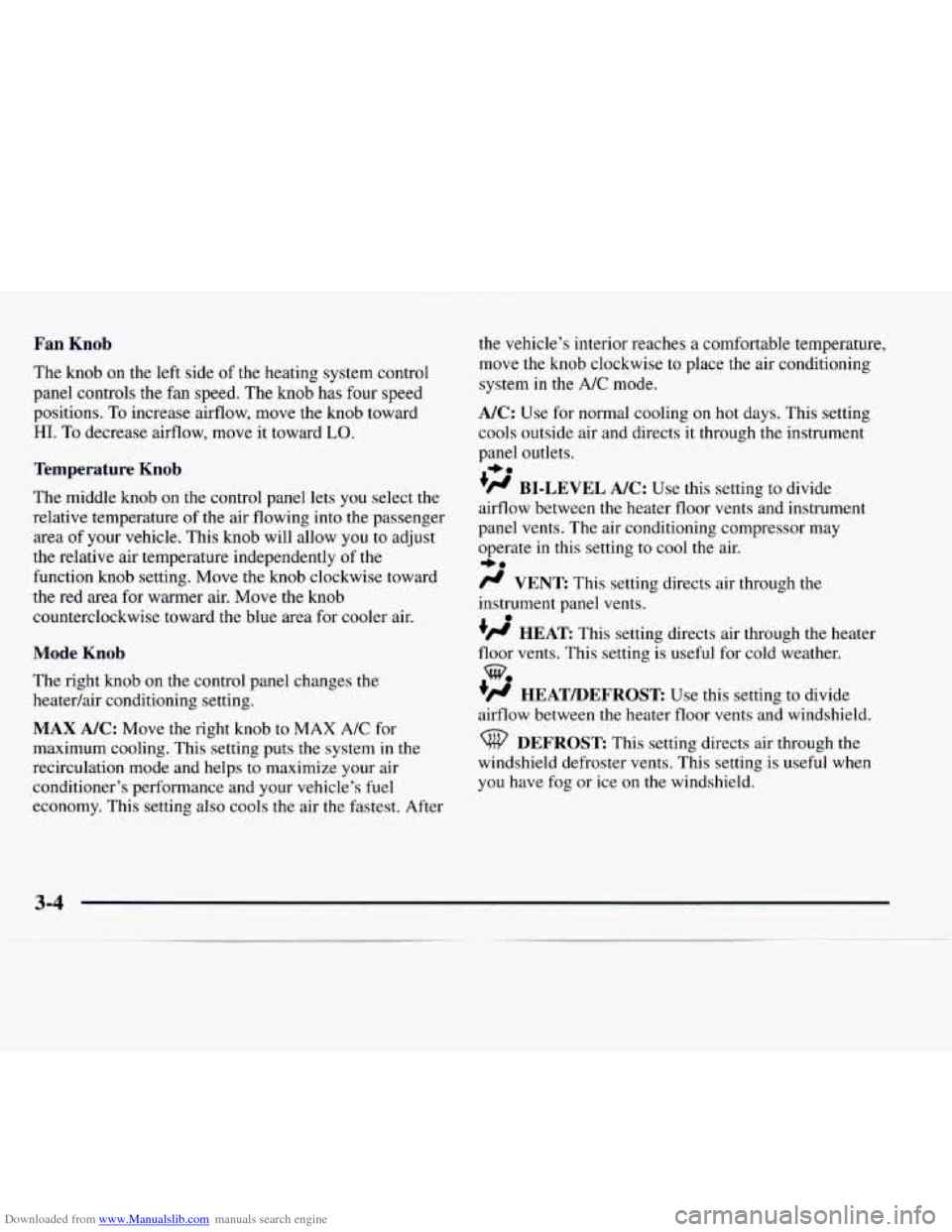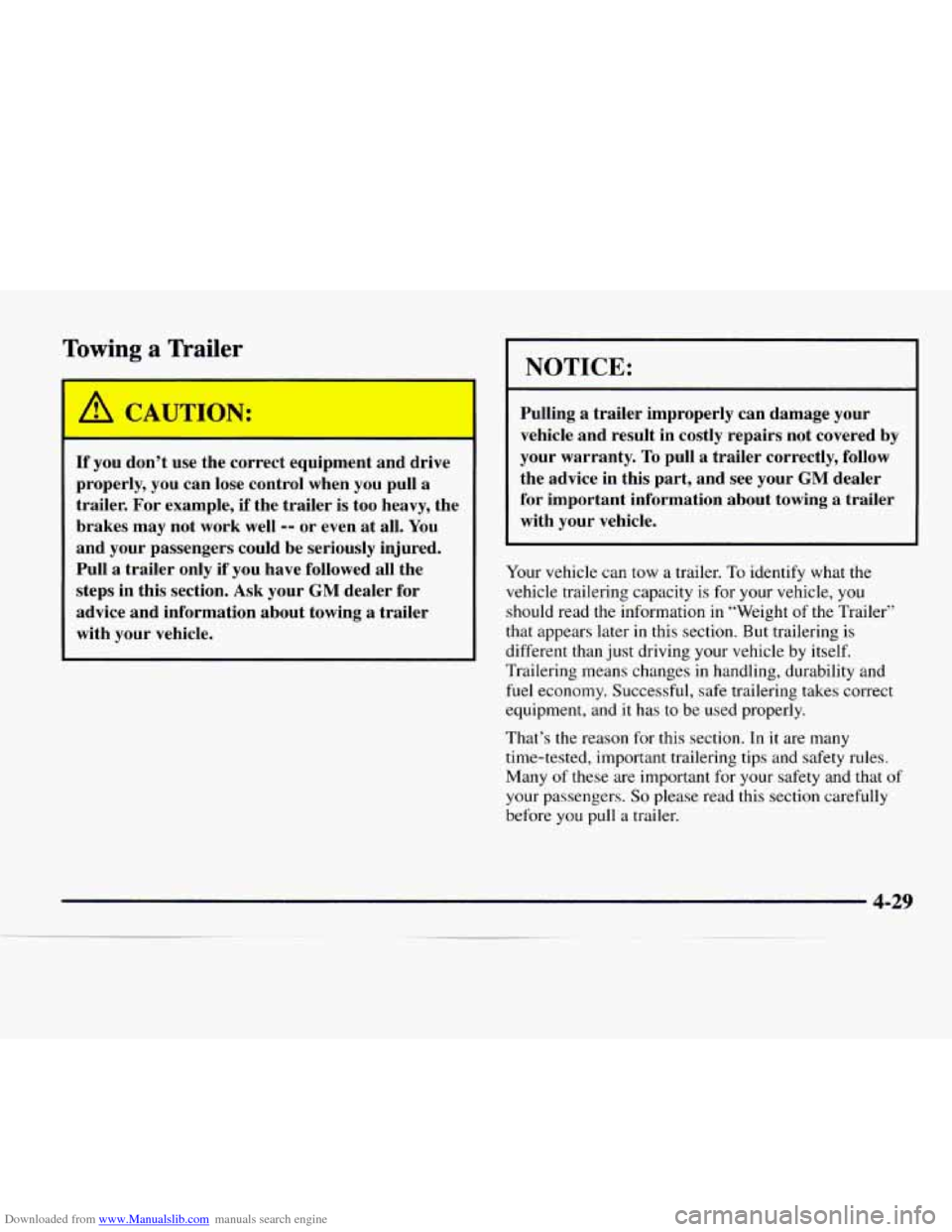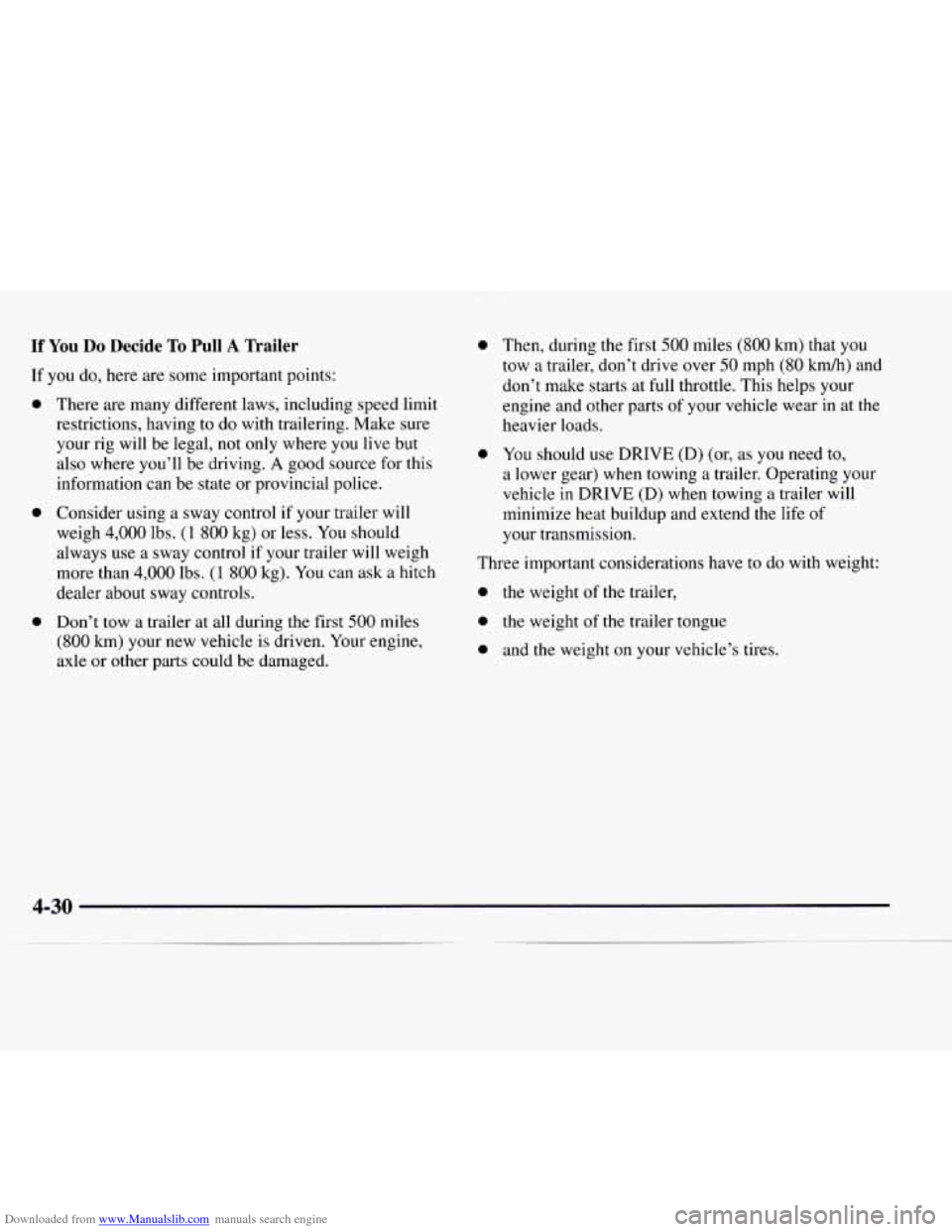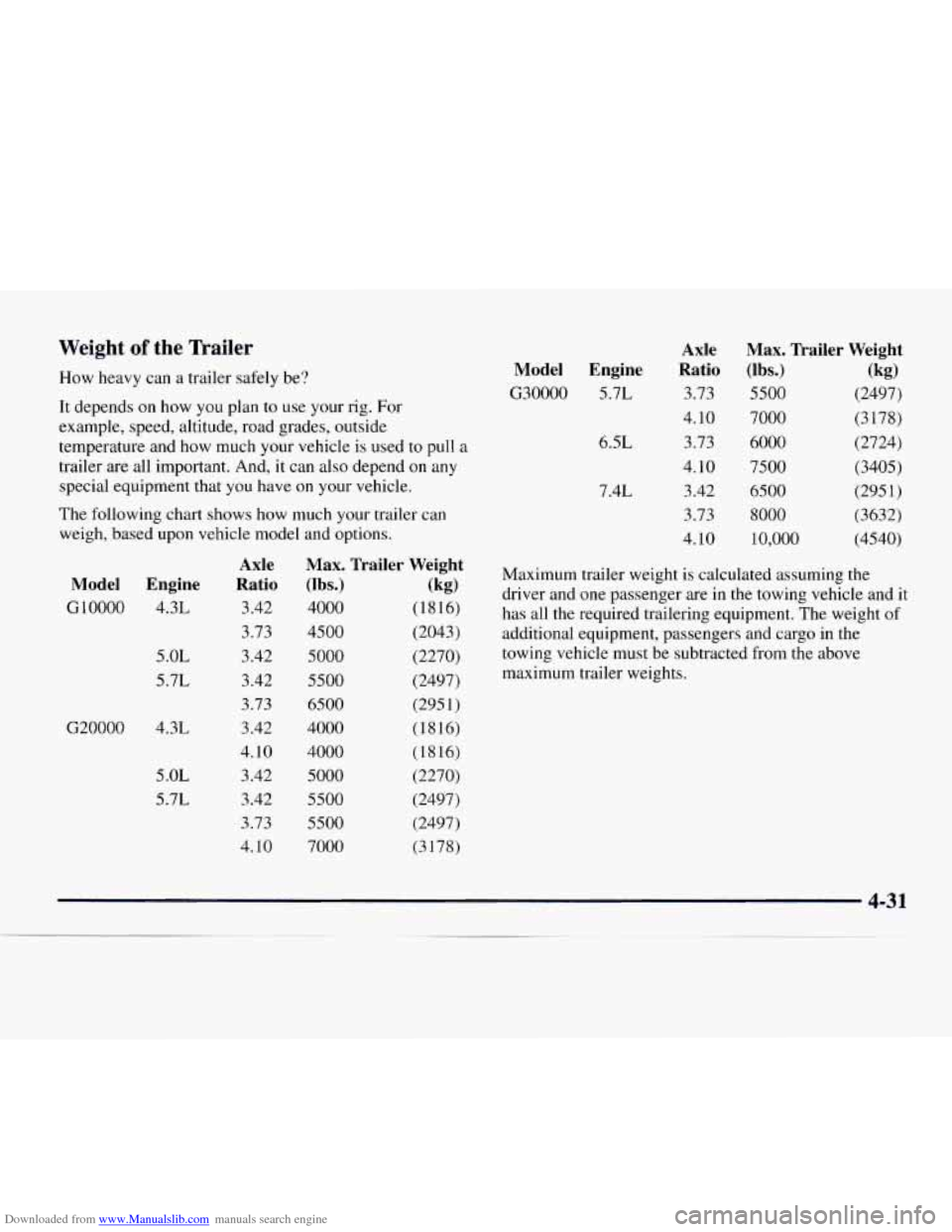Page 127 of 386

Downloaded from www.Manualslib.com manuals search engine Comfort Controls
This section tells you how to make your air system
work for you. Your comfort control system uses
ozone-friendly
R- 134a refrigerant.
With these
systems, you can control the heating,
cooling and ventilation
in your van. Your vehicle also
has a flow-through ventilation system described later
in this section.
Heater Controls
If your vehicle does not have air conditioning, your
heater controls will look like this.
Fan Knob
The left knob of the heating system control panel
controls the fan speed. The knob has four speed
positions. To increase airflow, move the knob toward
HI. To decrease airflow, move it toward LO. To turn the
fan off, move the mode knob on the far right to OFF.
Temperature Knob
The middle knob panel lets you select the relative
temperature of the air flowing into the passenger area
of your vehicle. This knob will allow
you to adjust the
relative air temperature independently of the function
knob setting. Move the knob clockwise toward the red
area for warmer air. Move the knob counter clockwise
toward the
blue area for cooler air.
3-2
Page 129 of 386

Downloaded from www.Manualslib.com manuals search engine Fan Knob
The knob on the left side of the heating system control
panel controls the fan speed. The knob has four speed
positions. To increase airflow, move the knob toward
HI. To decrease airflow, move it toward LO.
Temperature Knob
The middle knob on the control panel lets you select the
relative temperature of the air flowing into the passenger
area
of your vehicle. This knob will allow you to adjust
the relative air temperature independently
of the
function knob setting. Move the knob clockwise toward
the red area
for warmer air. Move the knob
counterclockwise toward the blue area for cooler air.
Mode Knob
The right knob on the control panel changes the
heatedair conditioning setting.
MAX A/C: Move the right knob to MAX A/C for
maximum cooling. This setting puts the system in the
recirculation mode and helps to maximize your air
conditioner’s performance and your vehicle’s fuel
economy. This setting also cools
the air the fastest. After the vehicle’s interior reaches
a comfortable temperature,
move the knob clockwise to place the air conditioning
system in the
A/C mode.
A/C: Use for normal cooling on hot days. This setting
cools outside air and directs it through the instrument
panel outlets.
‘fl BI-LEVEL A/C: Use this setting to divide
airflow between the heater floor vents and instrument
panel vents. The air conditioning compressor may
operate in this setting to cool the air.
/J VENT This setting directs air through the
instrument panel vents.
+H HEAT This setting directs air through the heater
floor vents. This setting is useful for cold weather.
+# HEATmEFROST: Use this setting to divide
airflow between the heater floor vents and windshield.
+e
I,.
0
we
DEFROST This setting directs air through the
windshield defroster vents. This setting is useful when
you have fog or ice
on the windshield.
3-4
-
Page 130 of 386
Downloaded from www.Manualslib.com manuals search engine Rear Heater (Without Air Conditioning)
If you have a rear heater (without rear air conditioning),
the control switch is located on the instrument panel.
To increase and decrease the flow
of heated air to the
rear floor vents, move the switch marked REAR HEAT
to the blower speed you want.
The
knob has three speed positions. To increase the flow
of heated air, move the switch toward HIGH. To turn the
fan
off, move the switch to OFF.
Rear Air Conditioning and Rear Heater
If your vehicle has a rear air conditioning and rear
heater system combination, controls are provided to
regulate the temperature, location and speed
of
the airflow.
Front Passenger Control
To adjust the air temperature, turn the temperature knob
on the right side
of the control panel.
3-5
Page 131 of 386
Downloaded from www.Manualslib.com manuals search engine For warmer air, turn the knob clockwise toward the red
side, and for cooler air, turn the knob counterclockwise
toward the blue side.
To regulate the airflow location, adjust the center knob
on the control panel. Turn the knob counterclockwise
for floor vent airflow or clockwise for headliner vent
airflow. Generally, the upper vents are used for air
conditioning and the floor vents
for heating. The
control knob can be set to any blend setting.
To adjust the airflow speed, turn the fan control knob
on the
left side of the control panel to the desired
blower setting.
To activate the rear control, move the fan knob on the
front control to REAR CNTL. Rear Passenger Control
The rear control works just like the front control. It will
allow second seat passengers to adjust the controls as
they desire.
3-6
Page 154 of 386
Downloaded from www.Manualslib.com manuals search engine Section 4 Your Driving and the Road
Here you’ll find information about driving on different kinds of roads and in varying weather conditions. We’ve also
included many other useful tips
on driving.
4-2
4-3
4-6 4-6
4-9
4-11 4-12
4- 13
4- 14 Defensive
Driving
Drunken Driving
Control
of a Vehicle
Braking
Steering
Off-Road Recovery
Passing
Loss of Control
Driving at Night 4-
16
4-19
4-20
4-2
1
4-22
4-22
4-24 4-27
4-29 Driving
in Rain and
on Wet Roads
City Driving
Freeway Driving
Before Leaving on a Long Trip
Highway Hypnosis Hill and Mountain Roads
Winter Driving
Loading Your Vehicle
Towing
a Trailer
Page 182 of 386

Downloaded from www.Manualslib.com manuals search engine Towing a Trailer
A CAUTION:
If you don’t use the correct equipment and drive
properly, you can lose control when you pull
a
trailer. For example, if the trailer is too heavy, the
brakes
may not work well -- or even at all. You
and your passengers could be seriously injured.
Pull
a trailer only if you have followed all the
steps in this section.
Ask your GM dealer for
advice and information about towing a trailer
with your vehicle.
NOTICE:
Pulling a trailer improperly can damage your
vehicle and result in costly repairs not covered by
your warranty.
To pull a trailer correctly, follow
the advice in this part, and see your
GM dealer
for important information about towing
a trailer
with your vehicle.
Your vehicle can tow a trailer. To identify what the
vehicle trailering capacity is for your vehicle, you
should read the information in “Weight of the Trailer’’
that appears later
in this section. But trailering is
different than just driving your vehicle by itself.
Trailering means changes in handling, durability and
fuel economy. Successful, safe trailering takes correct
equipment, and it has
to be used properly.
That’s the reason for this section.
In it are many
time-tested, important trailering tips and safety rules.
Many
of these are important for your safety and that of
your passengers. So please read this section carefully
before you pull a trailer.
Page 183 of 386

Downloaded from www.Manualslib.com manuals search engine If You Do Decide To Pull A Trailer
If you do, here are some important points:
0
0
0
There are many different laws, including speed limit
restrictions, having to do with trailering. Make sure
your rig will be legal, not only where you live but
also where you’ll be driving.
A good source for this
information can be state or provincial police.
Consider using a sway control if your trailer will
weigh
4,000 lbs. (I 800 kg) or less. You should
always
use a sway control if your trailer will weigh
more than
4,000 lbs. (1 800 kg). You can ask a hitch
dealer about sway controls.
Don’t tow a trailer at all during the first
500 miles
(800 km) your new vehicle is driven. Your engine,
axle or other parts could be damaged.
0
0 Then, during the first 500 miles (800 km) that you
tow a trailer, don’t drive over
50 mph (80 km/h) and
don’t make starts at full throttle. This helps your
engine and other parts of your vehicle wear in at the
heavier loads.
You should use DRIVE (D) (or, as you need to,
a lower gear) when towing a trailer. Operating your
vehicle
in DRIVE (D) when towing a trailer will
minimize heat buildup and extend
the life of
your transmission.
Three important considerations have to do with weight:
0 the weight of the trailer,
0 the weight of the trailer tongue
0 and the weight on your vehicle’s tires.
4-30
..
Page 184 of 386

Downloaded from www.Manualslib.com manuals search engine Weight of the Trailer
How heavy can a trailer safely be?
It depends on how you plan to use your rig.
For
example, speed, altitude, road grades, outside
temperature and how much your vehicle
is used to pull a
trailer are all important. And,
it can also depend on any
special equipment that you have on your vehicle.
The following chart shows how much your trailer can
weigh, based upon vehicle model and options.
Model
Engine
GlOOOO 4.3L
5 .OL
5.7L
G20000 4.3L
5 .OL
5.7L
Axle
Ratio
3.42
3.73
3.42
3.42
3.73
3.42
4.10 3.42
3.42 3.73
4.10
Max. Trailer Weight
(Ibs.) (kg)
4000 (1816)
4500 (2043)
5000 (2270)
5500 (2497)
6500 (295 1)
4000 (1816)
4000 (1816) 5000 (2270)
5500 (2497)
5500 (2497)
7000 (3 178)
Model
Engine
G30000 5.7L
6.5L
7.4L
Axle
Ratio
3.73
4.10
3.73
4.10 3.42
3.73
4.10
Max. Trailer Weight
(lbs.) (kg)
5500 (2497)
7000 (3 178)
6000 (2724)
7500 (3405)
6500 (295 1)
8000 (3632)
10,000 (4540)
Maximum trailer weight is calculated assuming the
driver and one passenger are
in the towing vehicle and it
has all the required trailering equipment. The weight
of
additional equipment, passengers and cargo in the
towing vehicle must be subtracted from the above
maximum trailer weights.